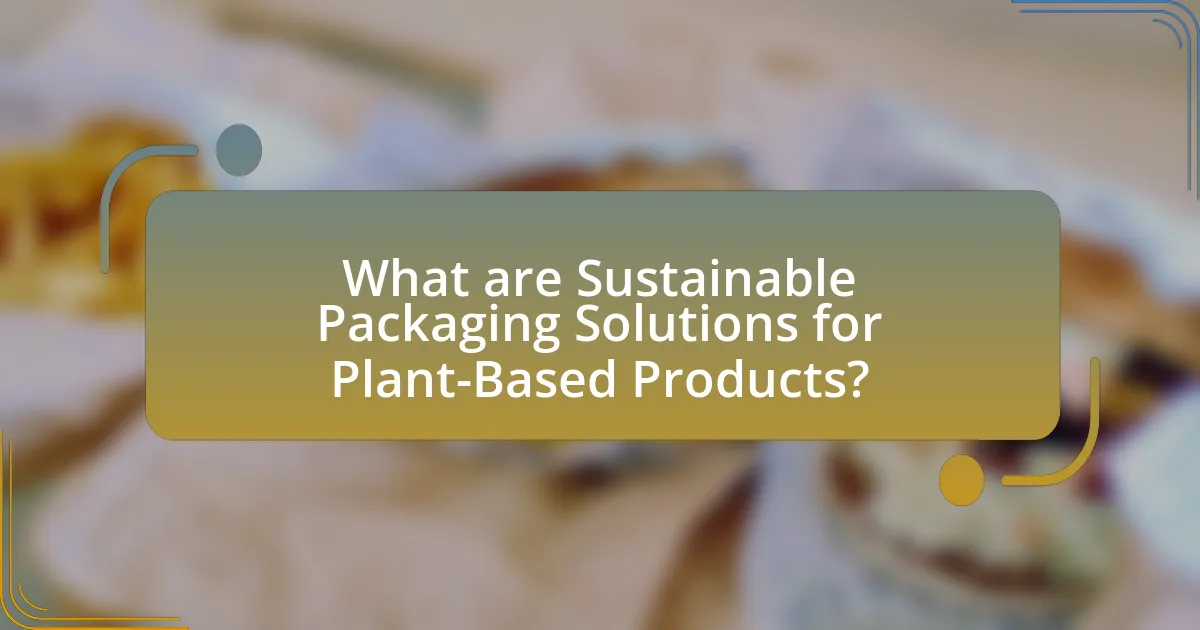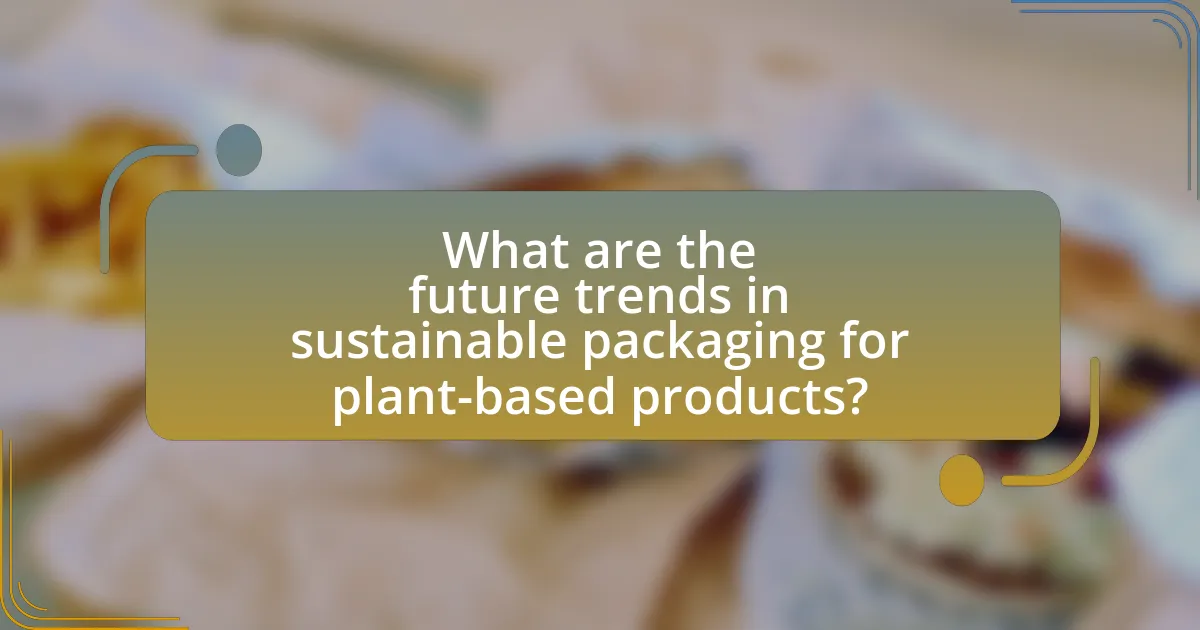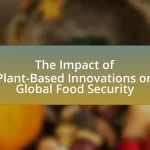Sustainable packaging solutions for plant-based products encompass biodegradable materials, compostable packaging, and recyclable options, significantly reducing environmental impact compared to traditional packaging. The article explores the differences between sustainable and conventional packaging, highlighting materials such as polylactic acid (PLA), recycled paper, and plant-based fibers. It addresses the importance of sustainable packaging in minimizing waste and pollution, driven by consumer demand and regulatory frameworks. Additionally, the article discusses the challenges companies face in adopting these solutions, including higher costs and logistical issues, while also examining innovations and future trends shaping the sustainable packaging landscape.

What are Sustainable Packaging Solutions for Plant-Based Products?
Sustainable packaging solutions for plant-based products include biodegradable materials, compostable packaging, and recyclable options. Biodegradable materials, such as polylactic acid (PLA) derived from corn starch, break down naturally in the environment, reducing landfill waste. Compostable packaging, like those made from paper or plant fibers, can decompose in composting facilities, returning nutrients to the soil. Recyclable options, such as glass and certain plastics, can be processed and reused, minimizing resource consumption. According to a report by Smithers Pira, the global market for sustainable packaging is expected to reach $500 billion by 2027, indicating a significant shift towards eco-friendly solutions in the packaging industry.
How do sustainable packaging solutions differ from traditional packaging?
Sustainable packaging solutions differ from traditional packaging primarily in their environmental impact and material composition. Traditional packaging often relies on non-renewable resources and contributes significantly to waste and pollution, whereas sustainable packaging utilizes biodegradable, recyclable, or compostable materials designed to minimize ecological harm. For instance, a study by the Ellen MacArthur Foundation highlights that transitioning to sustainable packaging could reduce plastic waste by 80% by 2040, demonstrating the potential for significant environmental benefits.
What materials are commonly used in sustainable packaging for plant-based products?
Common materials used in sustainable packaging for plant-based products include biodegradable plastics, recycled paper, and plant-based fibers. Biodegradable plastics, such as polylactic acid (PLA), are derived from renewable resources like corn starch and decompose more quickly than traditional plastics. Recycled paper is often utilized due to its lower environmental impact and ability to be repurposed multiple times. Plant-based fibers, such as those from sugarcane or bamboo, provide a renewable alternative to conventional materials, contributing to reduced carbon footprints. These materials are increasingly favored in the industry as they align with sustainability goals and consumer demand for eco-friendly packaging solutions.
How do these materials impact the environment compared to conventional options?
Sustainable materials significantly reduce environmental impact compared to conventional options. For instance, plant-based packaging often generates lower greenhouse gas emissions during production, with studies indicating a reduction of up to 50% compared to petroleum-based plastics. Additionally, these materials are typically biodegradable or compostable, which minimizes landfill waste and pollution. Research from the European Bioplastics Association shows that bioplastics can reduce fossil resource depletion by up to 80% when sourced from renewable materials. This evidence underscores the environmental benefits of adopting sustainable materials over traditional packaging solutions.
Why is sustainable packaging important for plant-based products?
Sustainable packaging is important for plant-based products because it minimizes environmental impact and supports the overall sustainability of the food system. The use of biodegradable or recyclable materials reduces waste and pollution, aligning with the eco-friendly ethos of plant-based products. For instance, a study published in the journal “Sustainability” found that using compostable packaging can significantly lower greenhouse gas emissions compared to traditional plastic packaging. This connection between sustainable packaging and environmental benefits reinforces the necessity for plant-based products to adopt eco-conscious packaging solutions.
What role does consumer demand play in the shift towards sustainable packaging?
Consumer demand significantly drives the shift towards sustainable packaging by influencing companies to adopt eco-friendly practices. As consumers increasingly prioritize environmental sustainability, they actively seek products with sustainable packaging, prompting brands to innovate and transition away from traditional materials. For instance, a 2021 survey by McKinsey found that 60% of consumers are willing to change their shopping habits to reduce environmental impact, highlighting the direct correlation between consumer preferences and packaging choices. This demand compels manufacturers to invest in sustainable materials and technologies, ultimately reshaping the packaging landscape in favor of environmentally responsible solutions.
How does sustainable packaging contribute to reducing waste and pollution?
Sustainable packaging significantly reduces waste and pollution by utilizing biodegradable, recyclable, or compostable materials that minimize environmental impact. These materials break down more easily than traditional plastics, leading to less accumulation in landfills and oceans. For instance, a study by the Ellen MacArthur Foundation found that transitioning to sustainable packaging could reduce plastic waste by 80% by 2040. Additionally, sustainable packaging often requires less energy and resources to produce, further decreasing carbon emissions associated with manufacturing processes.
What innovations are driving sustainable packaging solutions for plant-based products?
Innovations driving sustainable packaging solutions for plant-based products include the development of biodegradable materials, plant-based plastics, and compostable packaging. Biodegradable materials, such as those derived from cornstarch or sugarcane, break down naturally in the environment, reducing landfill waste. Plant-based plastics, made from renewable resources, offer a lower carbon footprint compared to traditional petroleum-based plastics. Compostable packaging, designed to decompose in industrial composting facilities, further supports sustainability by returning nutrients to the soil. According to a report by Smithers Pira, the global market for biodegradable and compostable packaging is projected to reach $18.6 billion by 2024, highlighting the growing demand for these innovative solutions in the plant-based sector.
What are the latest technologies in sustainable packaging design?
The latest technologies in sustainable packaging design include biodegradable materials, plant-based plastics, and smart packaging solutions. Biodegradable materials, such as polylactic acid (PLA) derived from corn starch, decompose naturally, reducing landfill waste. Plant-based plastics, like those made from sugarcane, offer a renewable alternative to traditional petroleum-based plastics, significantly lowering carbon footprints. Smart packaging technologies, which incorporate sensors and indicators, enhance product freshness and reduce waste by providing real-time information about the product’s condition. These advancements are supported by research indicating that sustainable packaging can reduce environmental impact by up to 30% compared to conventional options.
How are companies implementing biodegradable and compostable materials?
Companies are implementing biodegradable and compostable materials by integrating them into their packaging solutions and product designs. For instance, many food and beverage companies are replacing traditional plastic packaging with materials derived from plant sources, such as cornstarch or sugarcane, which break down more easily in natural environments. According to a report by Smithers Pira, the global market for biodegradable plastics is expected to reach $6.5 billion by 2023, indicating a significant shift towards sustainable materials. Additionally, companies like Unilever and Coca-Cola are actively investing in research and development to enhance the performance and affordability of these materials, ensuring they meet consumer demands while reducing environmental impact.

What challenges do companies face in adopting sustainable packaging solutions?
Companies face several challenges in adopting sustainable packaging solutions, including higher costs, limited availability of materials, and regulatory complexities. The transition to sustainable packaging often requires significant investment in new technologies and materials, which can increase production costs by 20-30% according to a 2021 report by Smithers Pira. Additionally, the supply chain for sustainable materials is not as developed as for traditional packaging, leading to shortages and inconsistent quality. Regulatory hurdles also complicate the adoption process, as companies must navigate varying standards and certifications across different regions, which can delay implementation and increase compliance costs.
What are the economic barriers to implementing sustainable packaging?
The economic barriers to implementing sustainable packaging include higher production costs, limited availability of sustainable materials, and the need for investment in new technologies. Higher production costs arise because sustainable materials often cost more than traditional packaging options, which can deter companies from making the switch. Limited availability of sustainable materials can restrict options for manufacturers, making it challenging to find cost-effective alternatives. Additionally, the need for investment in new technologies for production and recycling processes can pose a financial burden, especially for small to medium-sized enterprises. According to a report by the Ellen MacArthur Foundation, transitioning to sustainable packaging could require significant upfront investments, which many companies may find prohibitive.
How do production costs compare between sustainable and traditional packaging?
Production costs for sustainable packaging are generally higher than those for traditional packaging. This is primarily due to the use of more expensive raw materials and advanced manufacturing processes required for sustainable options. For instance, a study by Smithers Pira indicates that sustainable packaging can cost 10-30% more than conventional packaging due to factors such as sourcing renewable materials and implementing eco-friendly production techniques.
What financial incentives exist for companies to switch to sustainable options?
Companies can benefit financially from switching to sustainable options through cost savings, tax incentives, and enhanced market opportunities. Cost savings arise from reduced energy consumption and waste management expenses, as sustainable practices often lead to more efficient operations. Tax incentives, such as credits and deductions for using renewable resources or implementing eco-friendly technologies, can significantly lower a company’s tax burden. Additionally, the growing consumer demand for sustainable products allows companies to capture new market segments, potentially increasing revenue. For instance, a report by Nielsen indicates that 66% of global consumers are willing to pay more for sustainable brands, highlighting the financial advantage of adopting sustainable practices.
What logistical challenges arise with sustainable packaging solutions?
Sustainable packaging solutions face several logistical challenges, primarily related to sourcing materials, transportation, and storage. Sourcing sustainable materials often involves a limited supply chain, which can lead to increased costs and longer lead times. Transportation of these materials may also be complicated by their weight or fragility, requiring specialized handling and potentially increasing shipping costs. Additionally, storage of sustainable packaging can be challenging due to varying shelf lives and the need for specific environmental conditions to maintain material integrity. These factors collectively complicate the logistics of implementing sustainable packaging solutions effectively.
How does the supply chain impact the effectiveness of sustainable packaging?
The supply chain significantly impacts the effectiveness of sustainable packaging by influencing material selection, transportation efficiency, and waste management practices. Efficient supply chains enable the use of eco-friendly materials, such as biodegradable plastics or recycled paper, which are essential for sustainable packaging. For instance, a study by the Ellen MacArthur Foundation highlights that optimizing logistics can reduce carbon emissions by up to 30%, thereby enhancing the sustainability of packaging solutions. Additionally, effective supply chains facilitate the implementation of circular economy principles, allowing for better recycling and reuse of packaging materials, which further contributes to sustainability goals.
What are the challenges in sourcing sustainable materials?
The challenges in sourcing sustainable materials include limited availability, higher costs, and inconsistent quality. Limited availability arises because sustainable materials often depend on specific agricultural practices or natural resources that may not be widely accessible. Higher costs are a significant barrier, as sustainable materials can be more expensive to produce compared to conventional options, impacting overall pricing for manufacturers. Inconsistent quality can also pose a challenge, as variations in sourcing practices and environmental conditions can lead to fluctuations in material performance. These factors collectively hinder the widespread adoption of sustainable materials in packaging solutions for plant-based products.
How do regulatory frameworks affect sustainable packaging initiatives?
Regulatory frameworks significantly influence sustainable packaging initiatives by establishing guidelines and standards that promote environmentally friendly practices. These frameworks often mandate the use of recyclable materials, limit single-use plastics, and encourage the adoption of biodegradable alternatives. For instance, the European Union’s Single-Use Plastics Directive aims to reduce plastic waste by banning certain single-use plastic items and promoting sustainable packaging solutions. This regulatory pressure compels companies to innovate and invest in sustainable materials and technologies, thereby accelerating the transition towards eco-friendly packaging in the plant-based product sector.
What regulations are currently in place regarding sustainable packaging?
Currently, regulations regarding sustainable packaging vary by region but generally focus on reducing plastic waste and promoting recyclable materials. For instance, the European Union’s Single-Use Plastics Directive, effective from July 2021, bans specific single-use plastic items and mandates that member states achieve a 90% collection target for plastic bottles by 2029. In the United States, various states have enacted laws requiring the use of recyclable or compostable materials in packaging, such as California’s SB 54, which aims for a 75% reduction in single-use plastic waste by 2030. These regulations are designed to encourage the adoption of sustainable packaging practices and reduce environmental impact.
How can companies navigate compliance while innovating in packaging?
Companies can navigate compliance while innovating in packaging by integrating regulatory requirements into their design processes from the outset. This proactive approach ensures that packaging innovations align with existing laws, such as those related to materials safety, labeling, and environmental impact. For instance, companies can utilize materials that are both compliant with regulations and sustainable, such as biodegradable plastics or recycled materials, which meet the standards set by organizations like the Environmental Protection Agency. Additionally, engaging with regulatory bodies during the development phase can provide insights into upcoming changes in compliance requirements, allowing companies to adapt their innovations accordingly. This strategy not only mitigates the risk of non-compliance but also positions companies as leaders in sustainable practices within the plant-based product market.

What are the future trends in sustainable packaging for plant-based products?
Future trends in sustainable packaging for plant-based products include the increased use of biodegradable materials, innovative designs that reduce waste, and the adoption of circular economy principles. Biodegradable materials, such as plant-based plastics and compostable films, are gaining traction as they break down more easily in the environment compared to traditional plastics. Innovative designs focus on minimizing packaging size and maximizing functionality, which helps reduce overall material usage. Additionally, the circular economy approach emphasizes reusability and recyclability, encouraging brands to create packaging that can be repurposed or returned for reuse. These trends are supported by consumer demand for eco-friendly options, with a 2021 survey indicating that 74% of consumers are willing to pay more for sustainable packaging.
How is consumer behavior influencing the future of sustainable packaging?
Consumer behavior is significantly influencing the future of sustainable packaging by driving demand for eco-friendly materials and practices. As consumers increasingly prioritize sustainability, brands are responding by adopting biodegradable, recyclable, and compostable packaging solutions. A study by Nielsen indicates that 73% of global consumers are willing to change their consumption habits to reduce environmental impact, which compels companies to innovate in their packaging strategies. This shift not only reflects consumer preferences but also pressures manufacturers to invest in sustainable technologies, ultimately shaping the market landscape for plant-based products.
What emerging trends are shaping consumer preferences for packaging?
Emerging trends shaping consumer preferences for packaging include sustainability, minimalism, and transparency. Consumers increasingly favor eco-friendly materials, such as biodegradable and recyclable options, reflecting a growing awareness of environmental issues. For instance, a 2021 survey by McKinsey found that 67% of consumers consider sustainable packaging important when making purchasing decisions. Additionally, minimalistic designs that reduce waste and enhance product visibility are gaining traction, as they align with consumer desires for simplicity and clarity. Transparency in labeling, where brands disclose sourcing and production practices, is also becoming crucial, as consumers seek to make informed choices about the products they buy.
How can companies anticipate and adapt to changing consumer demands?
Companies can anticipate and adapt to changing consumer demands by leveraging data analytics and consumer feedback mechanisms. By analyzing purchasing patterns and preferences through tools like social media monitoring and sales data, companies can identify emerging trends in consumer behavior. For instance, a report by McKinsey & Company highlights that 70% of consumers are willing to pay more for sustainable packaging, indicating a shift towards eco-friendly products. This insight allows companies to innovate their packaging solutions to align with consumer expectations, ensuring they remain competitive in the market.
What role does collaboration play in advancing sustainable packaging solutions?
Collaboration plays a crucial role in advancing sustainable packaging solutions by enabling diverse stakeholders, including manufacturers, researchers, and policymakers, to share knowledge and resources. This collective effort fosters innovation, leading to the development of eco-friendly materials and technologies that reduce environmental impact. For instance, partnerships between companies and research institutions have resulted in breakthroughs such as biodegradable plastics derived from plant materials, which are essential for sustainable packaging in plant-based products. Additionally, collaborative initiatives like the Ellen MacArthur Foundation’s New Plastics Economy emphasize the importance of shared goals and strategies in creating a circular economy for packaging, demonstrating that joint efforts can significantly enhance sustainability outcomes.
How can partnerships between companies and organizations drive innovation?
Partnerships between companies and organizations can drive innovation by combining diverse expertise and resources to develop new solutions. For instance, collaborations between packaging companies and food manufacturers can lead to the creation of sustainable packaging materials tailored for plant-based products. A notable example is the partnership between Unilever and the Ellen MacArthur Foundation, which focuses on developing circular economy solutions, demonstrating how shared goals can accelerate innovation in sustainable practices. Such collaborations often result in faster problem-solving and the ability to leverage complementary strengths, ultimately leading to more effective and innovative outcomes in the industry.
What examples exist of successful collaborations in sustainable packaging?
Successful collaborations in sustainable packaging include the partnership between Unilever and the Ellen MacArthur Foundation, which focuses on creating a circular economy for plastics. This collaboration aims to reduce plastic waste and promote sustainable packaging solutions across Unilever’s product lines. Another example is the alliance between Coca-Cola and the World Wildlife Fund (WWF), which works on initiatives to improve packaging sustainability and reduce environmental impact. Additionally, the collaboration between Nestlé and the Bioplastic Feedstock Alliance aims to advance the use of bioplastics in packaging, enhancing sustainability in their product offerings. These partnerships demonstrate effective strategies for addressing sustainability challenges in packaging.
What best practices can companies adopt for effective sustainable packaging?
Companies can adopt several best practices for effective sustainable packaging, including using biodegradable materials, minimizing packaging size, and implementing a circular economy approach. Biodegradable materials, such as plant-based plastics, decompose naturally and reduce landfill waste, aligning with environmental goals. Minimizing packaging size not only conserves resources but also lowers transportation emissions, as smaller packages require less energy to transport. Implementing a circular economy approach encourages companies to design packaging that can be reused, recycled, or composted, thereby reducing the overall environmental impact. According to a report by the Ellen MacArthur Foundation, transitioning to a circular economy could generate $4.5 trillion in economic benefits by 2030, highlighting the financial viability of sustainable practices.
How can companies measure the impact of their sustainable packaging efforts?
Companies can measure the impact of their sustainable packaging efforts through metrics such as lifecycle assessments (LCA), consumer feedback, and waste reduction statistics. Lifecycle assessments evaluate the environmental impact of packaging from production to disposal, providing quantitative data on resource use and emissions. Consumer feedback can be gathered through surveys and sales data to assess market acceptance and preferences for sustainable packaging. Additionally, tracking waste reduction statistics, such as the percentage of recyclable or compostable materials used, offers concrete evidence of the effectiveness of sustainable packaging initiatives. These methods collectively provide a comprehensive view of the impact and effectiveness of sustainable packaging strategies.
What strategies can enhance the consumer appeal of sustainable packaging?
To enhance the consumer appeal of sustainable packaging, brands should focus on transparency, aesthetics, and functionality. Transparency involves clearly communicating the environmental benefits and sourcing of materials, which builds trust with consumers; for instance, a study by Nielsen found that 73% of millennials are willing to pay more for sustainable products. Aesthetics play a crucial role as visually appealing designs can attract consumers; research indicates that packaging design influences purchasing decisions significantly. Functionality ensures that the packaging meets consumer needs, such as being easy to open or resealable, which can improve user experience and satisfaction. By integrating these strategies, brands can effectively increase the attractiveness of their sustainable packaging to consumers.


